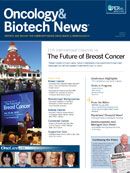Publication
Article
Subcutaneous Trastuzumab May Offer Benefits Over Standard IV Infusion in Patients With Breast Cancer
Author(s):
A new formulation of trastuzumab that is administered subcutaneously appears to be as effective as the approved bodyweight-based intravenous regimen in women with HER2-positive breast cancer.
Gustavo Ismael, MD
A new formulation of trastuzumab that is administered subcutaneously over approximately 5 minutes appears to be as effective as the approved bodyweight-based intravenous regimen given every 3 weeks in women with stage I to III HER2-positive breast cancer, according to results from the phase III HANNAH study.
Additionally, the subcutaneous formulation, which also has a similar pharmacokinetic profile and safety profile as the intravenous formulation, may also be a time-saver.
“The shortened duration of administration with subcutaneous trastuzumab compared with intravenous delivery suggests the potential for substantial time-saving for patients, physicians, and nursing staff,” Gustavo Ismael, MD, with the Amaral Carvalho Hospital in São Paulo, Brazil, and his coauthors wrote.
Overall, the new trastuzumab formulation may eventually represent a “valid alternative” to the conventional formulation, the researchers noted.
In the HANNAH study, 596 women were randomized 1:1 to either eight cycles of neoadjuvant chemotherapy administered concurrently with trastuzumab every 3 weeks either intravenously (8 mg/kg loading dose, 6 mg/kg maintenance dose) or subcutaneously (fixed dose of 600 mg). Chemotherapy consisted of four cycles of docetaxel (75 mg/m2) followed by 4 cycles of fluorouracil (500 mg/m2), epirubicin (75 mg/m2), and cyclophosphamide (500 mg/m2), every 3 weeks. After surgery, patients received intravenous or subcutaneous trastuzumab as assigned to completion of 1 year of treatment.
Study participants had newly diagnosed HER2-positive, operable, locally advanced or inflammatory breast cancer.
The coprimary endpoints were presurgery trastuzumab serum trough concentration (Ctrough) and pathological complete response (pCR).
The geometric mean presurgery Ctrough was 51.8 μg/mL (coefficient of variation, 52.5%) in the intravenous group and 69.0 μg/mL (55.8%) in the subcutaneous group. The geometric mean ratio of Ctrough subcutaneous to Ctrough intravenous was 1.33 (90% CI, 1.24-1.44).
Overall, 118 of 260 patients (45.4%) in the subcutaneous group and 107 (40.7%) of 263 patients in the intravenous group achieved a pCR. The difference between groups in pCR was 4.7% (95% CI, —4.0-13.4).
Thus, subcutaneous trastuzumab proved to be nonferior to the intravenous formulation with both primary endpoints, the authors wrote.
The two treatment groups had a similar incidence of grade 3 to 5 adverse events.
The authors said that in addition to improved convenience, subcutaneous trastuzumab leads to better compliance, a decrease in pharmacy preparation time, and optimization of medical resources.
They also emphasized that although pCR has been associated with long-term clinical benefit, pCR has not been validated as a surrogate endpoint for predicting clinical benefit. As such, study participants will be followed for at least 2 years, with the possibility of an extended follow-up being considered.
Finally, the researchers noted that the PREFHER study is assessing patient convenience with subcutaneous administration of trastuzumab along with patient preference for the route of administration and medical resource use in women with HER2-positive breast cancer.
Ismael G, Hegg R, Muehlbauer S, et al. Subcutaneous versus intravenous administration of (neo)adjuvant trastuzumab in patients with HER2-positive, clinical stage I—III breast cancer (HannaH study): a phase 3, open-label, multicentre, randomised trial. Lancet Oncol. 2012;13(9):869-878.










